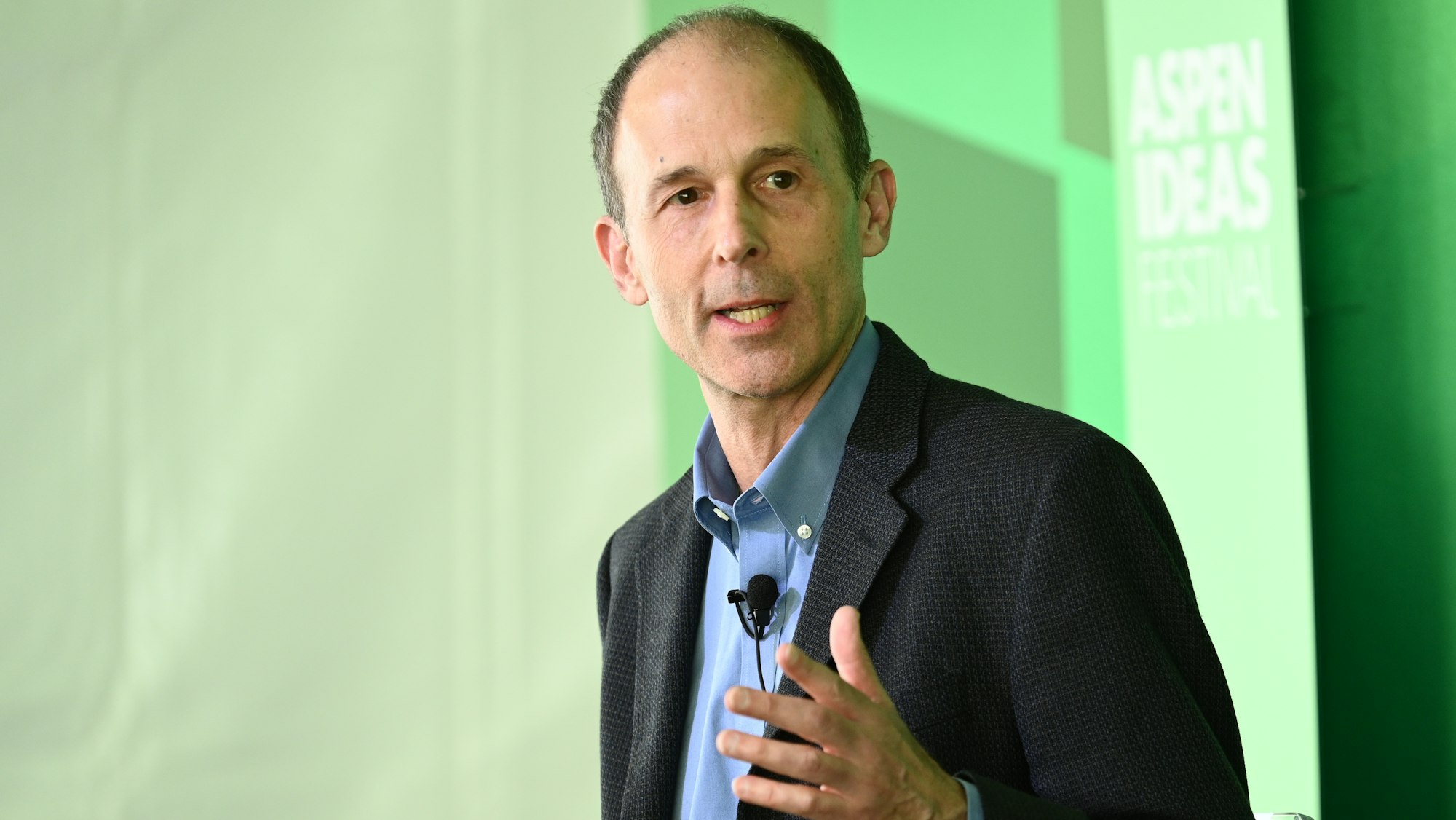
The Next Chapter in Energy is Here
Setup
A clean energy revolution is underway here, and across the globe. And it’s high time, considering electricity and heat are responsible for a staggering one-third of global emissions. Coal plants are shutting down, the costs of solar and wind technologies are rapidly falling, and a recent bipartisan bill looks to reestablish the United States as a leader in nuclear energy. How will the expansion of these technologies impact your wallet, and the planet? How are other countries effectively addressing the climate crisis as the demand for energy only increases? Hear from energy experts with refreshing ideas, and a U.S. senator at the helm of the future of energy policy.
- 2019 Festival
- Environment
- Technology
The politics of climate change policy are heating up
Panel moderator and environmental journalist Amy Harder asks Senator Jeff Merkley (D) of Oregon for a temperature reading on climate change policy efforts in D.C. and his home state:
A three-pillared plan to reshape US energy policy
According to Varun Sivaram, CTO of India’s largest renewable energy company, the US and other developed economies have to lead the renewable energy charge to give developing countries like India a chance to catch up. Because of India’s exploding demand for energy, transitioning that growth to renewable energy is both difficult and imperative. The US needs to buy the developing world time, and Sivaram has a plan.
How to Transform US energy policy
The first step involves massive investment in clean energy innovation — Sivaram says the US government should quadruple its current investment in research, development, and demonstration. The second step, a carbon tax and dividend plan, is supported by an all-star roster of Nobel Prize-winning economists and former Federal Reserve chairs. Finally, for the third step, Sivaram calls on the government to intervene in setting the architecture of the energy transition, from building a nationwide network of transmission lines to investing in parallel grids for hydrogen and carbon dioxide
Nuclear power can stymie the climate crisis, but should we let it?
Nuclear energy has been controversial since its development, and for good reason. But author and professor Joshua Goldstein says that nuclear energy is a tool we simply can’t afford to shun in our fight against climate change, and Varun Sivaram agrees:
Sivaram passionately claims that taking any option to reduce carbon emissions off the table, including nuclear power, is morally reprehensible. He argues that it's incumbent on wealthy countries such as the United States to decarbonize as rapidly as possible, to accommodate the longer timescale needed to decarbonize countries such as India that are also rapidly developing their economies at the same time.
EVs are great, but we have to think bigger
Although it’s easy to think that electric passenger vehicles are saving the world one charge at a time, Varun Sivaram says we should be prioritizing advances in heavy transportation (think industrial or commercial shipping) to truly make an impact. And he has some numbers to explain why.
Big IdeaTogether, heavy-duty transport (aviation, heavy trucking, and shipping), along with heavy industry—including cement steel and plastics—represent the 30% of global emissions that will be hardest to decarbonizeVarun Sivaram
Sivaram asserts that the best solution is not to focus on electrifying cargo planes and freighters, if only because the technology may prove unfeasible. Instead, we should be looking to alternative fuel sources to decarbonize these sectors. Joshua Goldstein chimes in to remind the panel, however, that it’s not an either/or situation. Transportation is important, yes, but so is the exponential growth in electricity demand that is just on the horizon.
China is a mixed bag on energy
Some of the most compelling renewable technologies are coming out of China, and China's put forth an unprecedented renewable energy plan. But China is also the world’s largest single carbon emitter by a huge margin. Amy Harder asks the panel to explain China’s present and future role in a decarbonized future:
Learn More
Additional Information
Explore More
Environment

Space… the final metaphor for the unknowable. But we are certainly trying to understand what goes on out there, and the more we learn, the more fascinating questions start to...


Few working technology reporters have been around as long as Kara Swisher. The start of her career coincided with the emergence of the internet, and she’s interviewed almost a...

Setting audacious goals helps to redefine what is achievable in health, medicine, and science. As we deepen understanding of the human genome, unravel the mysteries of the bra...


Each year brings more destructive natural disasters and growing evidence of the challenging future we face if we don’t address climate change. But the biggest cause of climate...


New technologies have always led to changes in society, though not always as quickly or drastically as people feared. Could artificial intelligence be different? Instead of le...


If we do absolutely nothing to mitigate climate change, scientists estimate the toll could be $38 trillion a year in damages. Industrialized countries like the United States,...

The recognition that all things are connected is at once a scientific principle and a philosophical touchstone. Humans, animals, and the environment are intertwined in complex...

Everywhere you look, there’s a headline about the power of artificial intelligence and how it will impact our lives in ways we have not yet imagined. From advancing medicine t...


Where will artificial intelligence be in five years, or 10 or 20? What happens if the technology is regulated? And if it isn’t? How will it shape the world and the way we live...


Whether they publicly tout it or not, U.S. technology companies play a powerful role in politics, cultural issues and the way we live. Founder and investor Peter Thiel is one...

A couple of degrees makes a world of difference — megafires, rising seas, failing infrastructure, and food systems require our immediate attention. Demands on dwindling natura...

Women are crucial to the climate movement, but their voices are often underrepresented and their work goes under-supported. Meet just a few of the women from this year’s Aspen...

AI has the potential to create vibrant, inclusive communities as civil society organizations harness it to tackle inequality, industry leverages it to foster fairer practices,...

Why do some conversations succeed while others stumble? The neurology and psychology of communication offer surprising explanations for why human connection goes right or wron...

Increasingly, AI informs our work output, our social views and our awareness of the world. Join SiriusXM host Mike Muse in conversation with Meta officials to explore the impl...

America’s teenagers are facing a mental health crisis; 1 in 3 teen girls say they’ve considered suicide in the past year. Many young people, parents and mental health professi...

Heat is now the top weather-related cause of death in the U.S., killing more people than hurricanes, floods and tornadoes combined. An environmental journalist and two city ch...

Every transition comes with tradeoffs, and even clean energy carries negative consequences. As they mine for critical minerals or build solar arrays on sensitive land, clean e...

Two billion people worldwide are set to vote in elections this year, amid global conflict, societal mistrust, broken information ecosystems — and the truth-destroying disrupti...

Amid seismic shifts in the entertainment world, Oscar-, Golden Globe- and Emmy-winning Brian Grazer has managed to keep pivoting to new ways to tell stories in movies, TV and...















